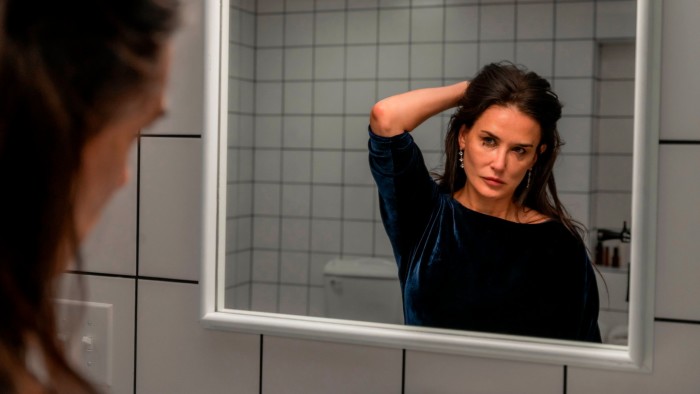Stay informed with free updates
Simply sign up to the Life & Arts myFT Digest — delivered directly to your inbox.
I’ve never been one to follow faddy beauty fashions — I’m deeply sceptical about treatments that promise to embalm one in the veneer of eternal youth.
But time’s a bitch, I’m six years older than this byline photo and I’ve reached that moment when, depending on the day (or more importantly the angle of my daughter’s iPhone), my face either presents as passable or like a Paleolithic find.
Hence, I have found myself resorting to ever wilder and largely desperate measures, such as lasers that zap away any spacklings of pigmentation, massages designed to amplify the cheekbones and lymphatic treatments that depuff the skin. I have electrocuted my chin to deal with muscle laxity issues around the jawline (Emface) and tried Ultherapy, a non-surgical lifting and tightening procedure that required a sedative before administering and is supposed to rejuvenate the neck. I have received an infusion of the longevity wonder supplement NAD+ which, according to some studies, is believed to modify, even reverse, the ageing process and is being investigated for use in the treatment of Alzheimer’s, some skin cancers and inflammatory disease. More persuasively, Hailey Bieber has used it, as has Joe Rogan and other celebrities.
You know something is amiss when you’re taking beauty tips from Joe Rogan, and even listing off the above procedures fills me with a sense of shame. The pursuit of youth is such a sad, pathetic, fruitless folly, it’s demeaning to admit. Neither do I need to be reminded that almost none of these treatments have been scientifically proven to really work. Though Lord knows what I would have looked like had I not done them. Perhaps I would now have 20 chins.
Of all the anti-ageing treatments, Botox remains one of the most popular. According to the American Society of Plastic Surgeons, 4.7mn botulinum toxin treatments were administered in the US in 2023. Sixty per cent of applications were for cosmetic reasons (Botox is also used to treat chronic migraine, incontinence and muscle spasticity, among many other things.) The market is projected to reach $21.6bn by 2032.
But according to some odd internal logic, I’ve always drawn the line at Botox and alternative injectables and fillers designed to smooth and paralyse the face. Possibly, I have avoided them because the results can be so variable — in the UK anyone with a licence, including non-medical professionals, can administer Botox provided they are “supervised”. But having happily ingested an IV-ful of God knows what, it seems a weak little prejudice to cling to. Botox has always represented a threshold I will not cross because it feels like cheating. And that’s the two-faced truth.
Beauty ideals always operate around strange personal tastes and double standards. We know it’s all largely snake oil, quackery and hoopla in the end. I find it laughable that anyone should harrumph about the legitimacy of wellness in the modern era — surely, only an idiot thinks these procedures will literally turn back the clock. We’ve been fleeced for centuries by the promise of age-reversing wonder drugs; there’s never even been compelling evidence to prove a pot of face cream does much good.
And yet we keep on slapping on the unguents and taking the tablets, because what else have we got?
In I Feel Bad About My Neck, a set of essays published in 2006, Nora Ephron writes brilliantly about the Sisyphean effort it takes merely to look presentable enough to leave the house. “I have never had plastic surgery, but I have done any number of things that fall just short of it,” she writes in “On Maintenance”, the essay that gives intelligent women permission to care about their looks. After a certain point, she writes, it’s all about the maintenance — “the routine, everyday things required just to keep you from looking like someone who no longer cares”.
Ephron was 65 when that essay was published. Sadly, the age of maintenance gets younger by the year. Hailey Bieber of the anti-ageing infusion advocacy is only 28. According to the International Society of Aesthetic Plastic Surgery, some 2.2mn Botox treatments in 2022 were administered to people between 18 and 34. I can’t imagine what an 18-year-old sees in the mirror that would persuade them to inject their face; but it’s a sad reflection of the glass-skinned world around us that is increasingly plastinated and wrinkle-free. Moreover, it’s unreasonable, how dare these kids muscle in: how am I meant to keep up with this cohort of children trying to maintain their already dewy, plump, newborn-like skin?
Perhaps wrinkles and grey hairs are nature’s way of inuring one to the darker truths of ageing — the real pains, losses and mysterious ills that will haunt one’s later years. By fixating on the surface we can defer the real anxieties of ageing by messing with supplements, hair dyes and creams.
I used to think my scowl lines lent me a certain fierceness, giving me gravitas in rooms of older folk. Now, I see other women (and men) with their nice boiled-egg-smooth foreheads, and wonder if I should do the same. Peering at the crevasse now etched between my eyebrows, however, I realise the youthful fierceness has mutated into something livid and permanent. I guess the line on Botox has been crossed for me. Any hope of forehead restoration is probably too late.
Find out about our latest stories first — follow FT Weekend on Instagram and X, and sign up to receive the FT Weekend newsletter every Saturday morning
